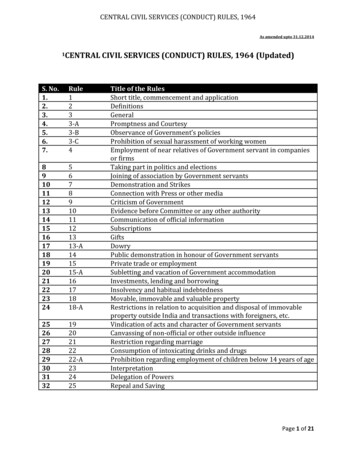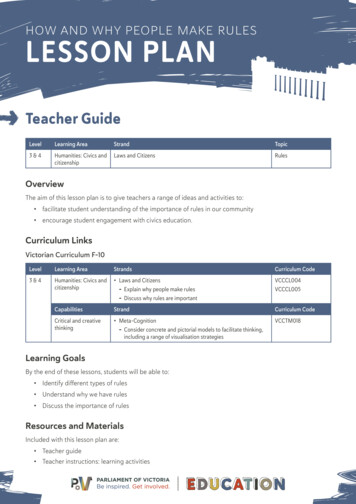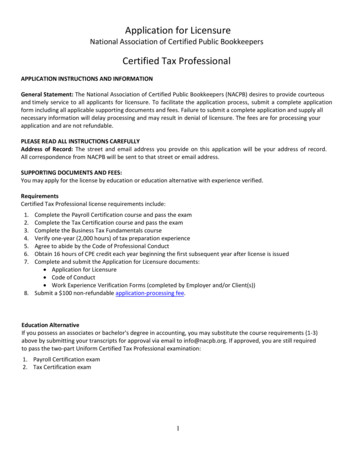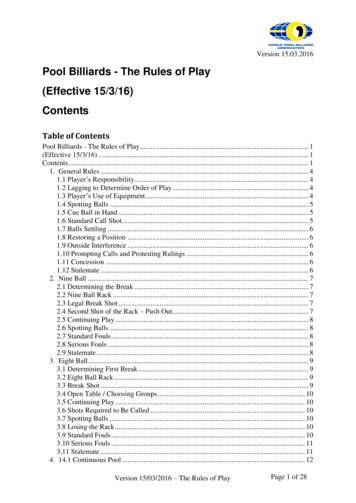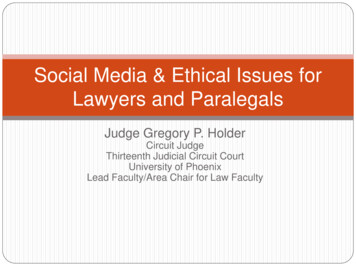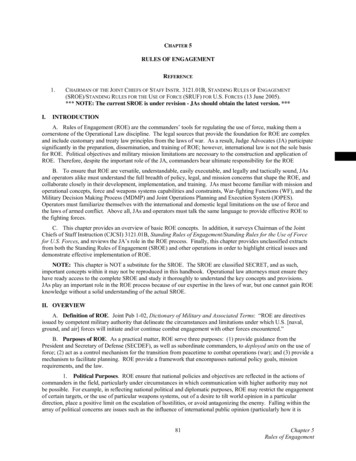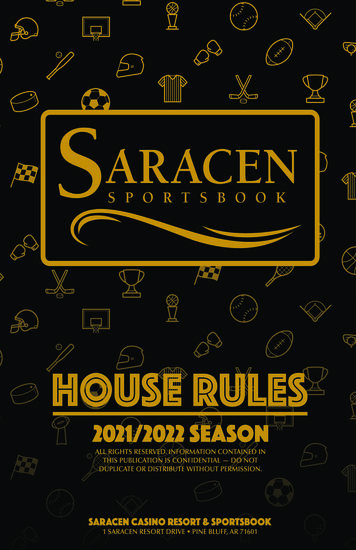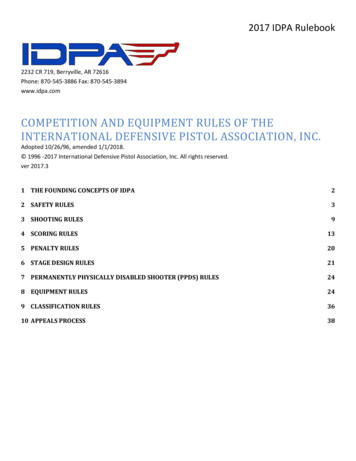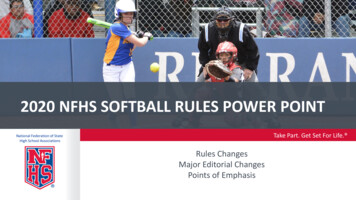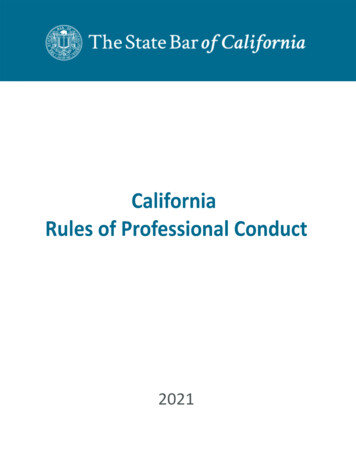
Transcription
CaliforniaRulesofProfessionalConduct2021
California Rules of Professional Conductand Other Related Rules and CodesVolume 1Rules of Professional ConductState Bar Act (Bus. & Prof. Code, §§ 6000 et seq.)“1992” Rules of Professional Conduct“1989” Rules of Professional Conduct“1975” Rules of Professional ConductRules Cross-Reference TablesPublished by the State Bar of CaliforniaOffice of Professional CompetencePub. No. 2502021PRODUCTION STAFFEDITORRandall DifuntorumPRODUCTION EDITORLauren McCurdyASSISTANT EDITORMimi LeeLEGISLATIVE RESEARCHMimi LeeLauren McCurdyAndrew TuftDISTRIBUTIONAngela MarlaudWEB PRODUCTIONMimi Lee
TABLE OF CONTENTSRULES OF PROFESSIONAL CONDUCTCROSS-REFERENCE TABLESRule 1.8.6 Compensation from One Other than Client17Current Rules to the “1992” Rulesiii“1992” Rules to the Current RulesviiRULES OF PROFESSIONAL CONDUCTRule 1.8.7 Aggregate Settlements18Rule 1.8.8 Limiting Liability to Client18Rule 1.8.9 Purchasing Property at a Foreclosure or aSale Subject to Judicial Review18Rule 1.0 Purpose and Function of the Rules ofProfessional Conduct1Rule 1.8.10 Sexual Relations with Current ClientRule 1.0.1 Terminology2Rule 1.8.11 Imputation of Prohibitions Under Rules1.8.1 to 1.8.919CHAPTER 1. LAWYER-CLIENT RELATIONSHIP3Rule 1.1 Competence3Rule 1.9 Duties to Former ClientsRule 1.2 Scope of Representation and Allocation ofAuthority4Rule 1.2.1 Advising or Assisting the Violation of Law 51819Rule 1.10 Imputation of Conflicts of Interest: GeneralRule20Rule 1.11 Special Conflicts of Interest for Former andCurrent Government Officials andEmployees21Rule 1.3 Diligence5Rule 1.4 Communication with Clients6Rule 1.12 Former Judge, Arbitrator, Mediator, orOther Third-Party Neutral23Rule 1.4.1 Communication of Settlement Offers6Rule 1.13 Organization as Client24Rule 1.4.2 Disclosure of Professional LiabilityInsuranceRule 1.14 [Reserved]266Rule 1.5 Fees for Legal Services7Rule 1.15 Safekeeping Funds and Property of Clientsand Other Persons*26Rule 1.5.1 Fee Divisions Among Lawyers8Rule 1.16 Declining or Terminating Representation 28Rule 1.6 Confidential Information of a Client8Rule 1.17 Sale of a Law Practice29Rule 1.7 Conflict of Interest: Current Clients12Rule 1.18 Duties to Prospective Client31Rule 1.8.1 Business Transactions with a Client andPecuniary Interests Adverse to a Client15CHAPTER 2. COUNSELOR32Rule 2.1 Advisor32Rule 1.8.2 Use of Current Client’s Information16Rule 2.2 [Reserved]32Rule 1.8.3 Gifts from Client16Rule 2.3 [Reserved]32Rule 1.8.4 [Reserved]16Rule 2.4 Lawyer as Third-Party Neutral32Rule 1.8.5 Payment of Personal or Business ExpensesIncurred by or for a Client162021Rule 2.4.1 Lawyer as Temporary Judge, Referee, orCourt-Appointed Arbitrator32i
TABLE OF CONTENTSCHAPTER 3. ADVOCATE33Rule 3.1 Meritorious Claims and Contentions33Rule 3.2 Delay of Litigation33Rule 3.3 Candor Toward the Tribunal*33Rule 3.4 Fairness to Opposing Party and Counsel35Rule 5.4 Financial and Similar Arrangements withNonlawyers46Rule 5.5 Unauthorized Practice of Law;Multijurisdictional Practice of Law48Rule 5.6 Restrictions on a Lawyer’s Right to Practice48Rule 5.7 [Reserved]49Rule 3.5 Contact with Judges, Officials, Employees,and Jurors35CHAPTER 6. PUBLIC SERVICE49Rule 3.6 Trial Publicity36Rule 6.1 [Reserved]49Rule 3.7 Lawyer as Witness37Rule 6.2 [Reserved]49Rule 3.8 Special Responsibilities of a Prosecutor38Rule 6.3 Membership in Legal Services Organization49Rule 3.9 Advocate in Nonadjudicative Proceedings 39Rule 6.4 [Reserved]49Rule 3.10 Threatening Criminal, Administrative, orDisciplinary Charges40Rule 6.5 Limited Legal Services Programs49CHAPTER 4. TRANSACTIONS WITH PERSONS* OTHERTHAN CLIENTS40CHAPTER 7. INFORMATION ABOUT LEGAL SERVICES50Rule 4.1 Truthfulness in Statements to OthersRule 7.1 Communications Concerning a Lawyer’sServices50Rule 7.2 Advertising51Rule 7.3 Solicitation of Clients5240Rule 4.2 Communication with a Represented Person*41Rule 4.3 Communicating with an UnrepresentedPerson*42Rule 4.4 Duties Concerning Inadvertently TransmittedWritings*43CHAPTER 5. LAW FIRMS* AND ASSOCIATIONSRule 5.1 Responsibilities of Managerial andSupervisory LawyersRule 7.4 Communication of Fields of Practice andSpecialization53Rule 7.5 Firm* Names and Trade Names53Rule 7.6 [Reserved]534343CHAPTER 8. MAINTAINING THE INTEGRITY OF THEPROFESSION53Rule 5.2 Responsibilities of a Subordinate Lawyer 44Rule 5.3 Responsibilities Regarding NonlawyerAssistantsRule 8.1 False Statement Regarding Application forAdmission to Practice Law5345Rule 5.3.1 Employment of Disbarred, Suspended,Resigned, or Involuntarily InactiveLawyer45iiRule 8.1.1 Compliance with Conditions of Disciplineand Agreements in Lieu of Discipline 54Rule 8.2 Judicial Officials54Rule 8.3 [Reserved]542021
TABLE OF CONTENTSRule 8.4 Misconduct54Rule 8.4.1 Prohibited Discrimination, Harassment andRetaliation55Rule 8.5 Disciplinary Authority; Choice of Law202157iii
RULES OF PROFESSIONAL CONDUCTCROSS-REFERENCE CHARTCurrent Rules of Professional Conduct“1992” Rules of Professional ConductEffective on November 1, 2018(Rule Number and Title)Effective until October 31, 2018(Rule Number and Title)1.0 Purpose and Function of the Rules of ProfessionalConduct1-100 Rules of Professional Conduct, in General1.0.1 Terminology1-100(B)1.1 Competence13-110 Failing to Act Competently1.2 Scope of Representation and Allocation of AuthorityNo Former California Rule Counterpart1.2.1 Advising or Assisting the Violation of Law3-210 Advising the Violation of Law1.3 Diligence3-110(B)21.4 Communication with Clients3-500 Communication1.4.1 Communication of Settlement Offers3-510 Communication of Settlement Offer1.4.2 Disclosure of Professional Liability Insurance3-410 Disclosure of Professional Liability Insurance1.5 Fees for Legal Services4-200 Fees for Legal Services1.5.1 Fee Divisions Among Lawyers2-200 Financial Arrangements Among Lawyers1.6 Confidential Information of a Client3-100 Confidential Information of a Client1.7 Conflict of Interest: Current Clients3-310(B),(C) [Avoiding the Representation of AdverseInterests]3-320 Relationship With Other Party’s Lawyer1.8.1 Business Transactions with a Client and PecuniaryInterests Adverse to the Client3-300 Avoiding Interests Adverse to a Client1.8.2 Use of Current Client’s InformationNo Former California Rule Counterpart31.8.3 Gifts from Client4-400 Gifts From Client1.8.5 Payment of Personal or Business Expenses Incurred byor for a Client4-210 Payment of Personal or Business Expenses Incurred byor for a Client1.8.6 Compensation from One Other than Client3-310(F)1.8.7 Aggregate Settlements3-310(D)1.8.8 Limiting Liability to Client3-400 Limiting Liability to Client1.8.9 Purchasing Property at a Foreclosure or a Sale Subject toJudicial Review4-300 Purchasing Property at a Foreclosure or a Sale Subjectto Judicial Review1.8.10 Sexual Relations with Current Client3-120 Sexual Relations With Client1.8.11 Imputation of Prohibitions Under Rules 1.8.1 to 1.8.9No Former California Rule Counterpart1Rule 1.1, Comment [1] was added by order of the Supreme Court, effective March 22, 2021.2Rule 3-110(B) provides:(B) For purposes of this rule, "competence" in any legal service shall mean to apply the 1) diligence, 2)learning and skill, and 3) mental, emotional, and physical ability reasonably necessary for the performanceof such service. (Emphasis added.)3But see Cal. Bus. & Prof. Code § 6068(e)(1).2021i
RULES OF PROFESSIONAL CONDUCTCROSS-REFERENCE CHARTCurrent Rules of Professional Conduct“1992” Rules of Professional ConductEffective on November 1, 2018(Rule Number and Title)Effective until October 31, 2018(Rule Number and Title)1.9 Duties To Former Clients3-310(E)1.10 Imputation of Conflicts of Interest: General RuleNo Former California Rule Counterpart1.11 Special Conflicts of Interest for Former and CurrentGovernment Officials and EmployeesNo Former California Rule Counterpart1.12 Former Judge, Arbitrator, Mediator or Other Third-PartyNeutralNo Former California Rule Counterpart1.13 Organization as Client3-600 Organization as Client1.14[Reserved]41.15 Safekeeping Funds and Property of Clients and OtherPersons4-100 Preserving Identity of Funds and Property of a Client1.16 Declining or Terminating Representation53-700 Termination of Employment1.17 Sale of a Law Practice2-300 Sale or Purchase of a Law Practice of a Member, Livingor Deceased1.18 Duties to Prospective ClientNo Former California Rule Counterpart2.1 AdvisorNo Former California Rule Counterpart2.2 [Reserved]62.3 [Reserved]72.4 Lawyer as Third-Party NeutralNo Former California Rule Counterpart2.4.1 Lawyer as Temporary Judge, Referee, or CourtAppointed Arbitrator1-710 Member as Temporary Judge, Referee, or CourtAppointed Arbitrator3.1 Meritorious Claims and Contentions3-200 Prohibited Objectives of Employment3.2 Delay of LitigationNo Former California Rule Counterpart3.3 Candor Toward the Tribunal5-200(A)-(D) Trial Conduct3.4 Fairness to Opposing Party and Counsel5-200(E) [Trial Conduct]5-220 Suppression of Evidence(Note: Rule 5-220 was revised effective May 1, 2017.)5-310 Prohibited Contact With Witnesses(Note: See also Rule 5-110 was revised effective November 2,2017.)3.5 Contact with Judges, Officials, Employees, and Jurors5-300 Contact With Officials5-320 Contact With Jurors3.6 Trial Publicity5-120 Trial Publicity3.7 Lawyer as Witness5-210 Member as Witness4ABA Model Rule 1.14 (“Client With Diminished Capacity”) has not been adopted in California.5Rule 1.16, Comment [5] was amended by order of the Supreme Court, effective June 1, 2020.6ABA Model Rule 2.2 was deleted and has not been adopted in California.7ABA Model Rule 2.3 (“Evaluation For Use By Third Persons”) has not been adopted in California.ii2021
RULES OF PROFESSIONAL CONDUCTCROSS-REFERENCE CHARTCurrent Rules of Professional Conduct“1992” Rules of Professional ConductEffective on November 1, 2018(Rule Number and Title)Effective until October 31, 2018(Rule Number and Title)3.8 Special Responsibilities of a Prosecutor85-110 Performing the Duty of Member in Government Service(Note: Rule 5-110 was revised effective November 2, 2017.)3.9 Advocate in Non-adjudicative ProceedingsNo Former California Rule Counterpart3.10 Threatening Criminal, Administrative, or DisciplinaryCharges5-100 Threatening Criminal, Administrative, or DisciplinaryCharges4.1 Truthfulness in Statements to OthersNo Former California Rule Counterpart4.2 Communication with a Represented Person2-100 Communication With a Represented Party4.3 Communicating with an Unrepresented PersonNo Former California Rule Counterpart4.4 Duties Concerning Inadvertently Transmitted WritingsNo Former California Rule Counterpart5.1 Responsibilities of Managerial and Supervisory LawyersNo Former California Rule Counterpart95.2 Responsibilities of a Subordinate LawyerNo Former California Rule Counterpart5.3 Responsibilities Regarding Nonlawyer AssistantsNo Former California Rule Counterpart105.3.1 Employment of Disbarred, Suspended, Resigned, orInvoluntarily Inactive Lawyer1-311 Employment of Disbarred, Suspended, Resigned, orInvoluntarily Inactive Members5.4 Financial and Similar Arrangements with Nonlawyers111-310 Forming a Partnership With a Non-Lawyer1-320 Financial Arrangements With Non-Lawyer1-600 Legal Service Programs5.5 Unauthorized Practice of Law; Multijurisdictional Practiceof Law1-300 Unauthorized Practice of Law5.6 Restrictions on a Lawyer’s Right to Practice1-500 Agreements Restricting a Member's Practice6.3 Membership in Legal Services OrganizationsNo Former California Rule Counterpart6.5 Limited Legal Services Programs1-650 Limited Legal Service Programs7.1 Communications Concerning a Lawyer’s Services1-400 Advertising and Solicitation7.2 Advertising1-320(B)-(C) & (A)(4) [Financial Arrangements With NonLawyer]1-400 Advertising and Solicitation2-200 Financial Arrangements Among Lawyers7.3 Solicitation of Clients1-400 Advertising and Solicitation7.4 Communication of Fields of Practice and Specialization1-400 Advertising and Solicitation7.5 Firm Names and Trade Names1-400 Advertising and Solicitation7.6 [Reserved]128Rule 3.8, Comment [7] was amended by order of the Supreme Court, effective June 1, 2020.9But see rule 3-110, Discussion ¶. 1.10But see rule 3-110, Discussion ¶. 1.11Rule 5.4 was amended by order of the Supreme Court, effective March 22, 2021.2021iii
RULES OF PROFESSIONAL CONDUCTCROSS-REFERENCE CHARTCurrent Rules of Professional Conduct“1992” Rules of Professional ConductEffective on November 1, 2018(Rule Number and Title)Effective until October 31, 2018(Rule Number and Title)8.1 False Statement Regarding Application for Admission toPractice Law1-200 False Statement Regarding Admission to the State Bar8.1.1 Compliance with Conditions of Discipline andAgreements in Lieu of Discipline1-110 Disciplinary Authority of the State Bar8.2 Judicial Officials1-700 Member as Candidate for Judicial Office8.3[Reserved]138.4 Misconduct1-120 Assisting, Soliciting, or Inducing Violations8.4.1 Prohibited Discrimination, Harassment and Retaliation2-400 Prohibited Discriminatory Conduct in a Law Practice8.5 Disciplinary Authority; Choice of Law1-100(D) Rules of Professional Conduct, in General12ABA Model Rule 7.6 (“Political Contributions To Obtain Legal Engagements Or Appointments By Judges”) has notbeen adopted in California.13ivABA Model Rule 8.3 (“Reporting Professional Misconduct”) has not been adopted in California.2021
RULES OF PROFESSIONAL CONDUCTCROSS-REFERENCE CHART“1992” Rules of Professional ConductCurrent Rules of Professional ConductEffective until October 31, 2018(Rule Number and Title)Effective on November 1, 2018(Rule Number and Title)1-100(A) [Rules of Professional Conduct, in General]1.0 Purpose and Function of the Rules of Professional Conduct1-100(B)1.0.1 Terminology1-100(D)8.5 Disciplinary Authority; Choice of Law1-110 Disciplinary Authority of the State Bar8.1.1 Compliance with Conditions of Discipline andAgreements in Lieu of Discipline1-120 Assisting, Soliciting, or Inducing Violations8.4 Misconduct1-200 False Statement Regarding Admission to the State Bar8.1 False Statement Regarding Application for Admission toPractice Law1-300 Unauthorized Practice of Law5.5 Unauthorized Practice of Law; Multijurisdictional Practiceof Law1-310 Forming a Partnership With a Non-Lawyer5.4 Financial and Similar Arrangements with Nonlawyers141-311 Employment of Disbarred, Suspended, Resigned, orInvoluntarily Inactive Members5.3.1 Employment of Disbarred, Suspended, Resigned, orInvoluntarily Inactive Lawyer1-320(A)5.4 Financial and Similar Arrangements with Nonlawyers151-320(A)(4) & (B)-(C) [Financial Arrangements With NonLawyer]7.2(b) Advertising1-400 Advertising and Solicitation7.1 Communications Concerning a Lawyer’s Services7.2 Advertising7.3 Solicitation of Clients7.4 Communication of Fields of Practice and Specialization7.5 Firm Names and Trade Names1-500 Agreements Restricting a Member's Practice5.6 Restrictions on a Lawyer’s Right to Practice1-600 Legal Service Programs5.4 Financial and Similar Arrangements with Nonlawyers161-650 Limited Legal Service Programs6.5 Limited Legal Services Programs1-700 Member as Candidate for Judicial Office8.2 Judicial Officials1-710 Member as Temporary Judge, Referee, or CourtAppointed Arbitrator2.4.1 Lawyer as Temporary Judge, Referee, or CourtAppointed Arbitrator2-100 Communication With a Represented Party4.2 Communication with a Represented Person2-200(A) Financial Arrangements Among Lawyers1.5.1 Fee Divisions Among Lawyers2-200(B)7.2(b) Advertising2-300 Sale or Purchase of a Law Practice of a Member, Living orDeceased1.17 Sale of a Law Practice2-400 Prohibited Discriminatory Conduct in a Law Practice8.4.1 Prohibited Discrimination, Harassment and Retaliation3-100 Confidential Information of a Client1.6 Confidential Information of a Client14Rule 5.4 was amended by order of the Supreme Court, effective March 22, 2021.15Rule 5.4 was amended by order of the Supreme Court, effective March 22, 2021.16Rule 5.4 was amended by order of the Supreme Court, effective March 22, 2021.2021v
RULES OF PROFESSIONAL CONDUCTCROSS-REFERENCE CHART“1992” Rules of Professional ConductCurrent Rules of Professional ConductEffective until October 31, 2018(Rule Number and Title)Effective on November 1, 2018(Rule Number and Title)3-110 Failing to Act Competently1.1 Competence173-110(B)1.3 Diligence3-110, Discussion ¶.1Rule 5.1 Responsibilities of Managerial and SupervisoryLawyersRule 5.2 Responsibilities of a Subordinate LawyerRule 5.3 Responsibilities Regarding Nonlawyer Assistants3-120 Sexual Relations With Client1.8.10 Sexual Relations with Current Client3-200 Prohibited Objectives of Employment3.1 Meritorious Claims and Contentions3-210 Advising the Violation of Law1.2.1 Advising or Assisting the Violation of Law3-300 Avoiding Interests Adverse to a Client1.8.1 Business Transactions with a Client and PecuniaryInterests Adverse to the Client3-310(B), (C) Avoiding the Representation of Adverse Interests1.7 Conflict of Interest: Current Clients3-310(D)1.8.7 Aggregate Settlements3-310(E)1.9 Duties To Former Clients3-310(F)1.8.6 Compensation from One Other than Client3-320 Relationship With Other Party’s Lawyer1.7(c)(2) Conflict of Interest: Current Clients3-400 Limiting Liability to Client1.8.8 Limiting Liability to Client3-410 Disclosure of Professional Liability Insurance1.4.2 Disclosure of Professional Liability Insurance3-500 Communication1.4 Communication with Clients3-510 Communication of Settlement Offer1.4.1 Communication of Settlement Offers3-600 Organization as Client1.13 Organization as Client3-700 Termination of Employment1.16 Declining or Terminating Representation 184-100 Preserving Identity of Funds and Property of a Client1.15 Safekeeping Funds and Property of Clients and OtherPersons4-200 Fees for Legal Services1.5 Fees for Legal Services4-210 Payment of Personal or Business Expenses Incurred by orfor a Client1.8.5 Payment of Personal or Business Expenses Incurred by orfor a Client4-300 Purchasing Property at a Foreclosure or a Sale Subject toJudicial Review1.8.9 Purchasing Property at a Foreclosure or a Sale Subject toJudicial Review4-400 Gifts From Client1.8.3 Gifts from Client5-100 Threatening Criminal, Administrative, or DisciplinaryCharges3.10 Threatening Criminal, Administrative, or DisciplinaryCharges17Rule 1.1, Comment [1] was added by order of the Supreme Court, effective March 22, 2021.18Rule 1.16, Comment [5] was amended by order of the Supreme Court, effective June 1, 2020.vi2021
RULES OF PROFESSIONAL CONDUCTCROSS-REFERENCE CHART“1992” Rules of Professional ConductCurrent Rules of Professional ConductEffective until October 31, 2018(Rule Number and Title)Effective on November 1, 2018(Rule Number and Title)5-110 Performing the Duty of Member in Government Service3.8 Special Responsibilities of a Prosecutor19(Note: Rule 5-110 was revised effectiveNovember 2, 2017.)5-120 Trial Publicity3.6 Trial Publicity5-200(A)-(D) Trial Conduct3.3 Candor Toward the Tribunal5-200(E) Trial Conduct3.4 Fairness to Opposing Party and Counsel5-210 Member as Witness3.7 Lawyer as Witness5-220 Suppression of Evidence3.4 Fairness to Opposing Party and Counsel(Note: Rule 5-220 was revised effective May 1, 2017.)(Note: See also Rule 3.8(d) regarding the duties of aprosecutor.)5-300 Contact With Officials3.5 Contact with Judges, Officials, Employees, and Jurors5-310 Prohibited Contact With Witnesses3.4 Fairness to Opposing Party and Counsel5-320 Contact With Jurors3.5 Contact with Judges, Officials, Employees, and JurorsCurrent Rules With No Former California Rule CounterpartRule 1.2 Scope of Representation and Allocation of AuthorityRule 1.8.2 Use of Current Client’s Information20Rule 1.8.11 Imputation of Prohibitions Under Rules 1.8.1 to 1.8.9Rule 1.10 Imputation of Conflicts of Interest: General RuleRule 1.11 Special Conflicts of Interest for Former and Current Government Officials and EmployeesRule 1.12 Former Judge, Arbitrator, Mediator or Other Third-Party NeutralRule 1.18 Duties to Prospective ClientRule 2.1 AdvisorRule 2.4 Lawyer as Third-Party NeutralRule 3.2 Delay of LitigationRule 3.9 Advocate in Non-adjudicative ProceedingsRule 4.1 Truthfulness in Statements to OthersRule 4.3 Communicating with an Unrepresented Person21Rule 4.4 Duties Concerning Inadvertently Transmitted WritingsRule 5.3 Responsibilities Regarding Nonlawyer AssistantsRule 6.3 Membership in Legal Services Organizations19Rule 3.8, Comment [7] was amended by order of the Supreme Court, effective June 1, 2020.20But see Bus. & Prof. Code § 6068(e).21But see current rule 3-600(D) regarding similar duties in an organizational context.2021vii
viii2021
RULES OF PROFESSIONAL CONDUCT(On May 10, 2018, the California Supreme Courtissued an order approving new Rules of ProfessionalConduct, which are effective on November 1, 2018 OnSeptember 26, 2018, the Court issued an orderapproving non-substantive clean-up revisions to therules. These revisions are effective on the same date.)Rule 1.0 Purpose and Function of the Rules ofProfessional Conduct(a)Purpose.The following rules are intended to regulateprofessional conduct of lawyers through discipline.They have been adopted by the Board of Trustees ofthe State Bar of California and approved by theSupreme Court of California pursuant to Business andProfessions Code sections 6076 and 6077 to protectthe public, the courts, and the legal profession;protect the integrity of the legal system; and promotethe administration of justice and confidence in thelegal profession. These rules together with anystandards adopted by the Board of Trustees pursuantto these rules shall be binding upon all lawyers.(b)Function.(1) A willful violation of any of these rules is abasis for discipline.(2) The prohibition of certain conduct in theserules is not exclusive. Lawyers are also bound byapplicable law including the State Bar Act (Bus. &Prof. Code, § 6000 et seq.) and opinions ofCalifornia courts.(3) A violation of a rule does not itself give riseto a cause of action for damages caused byfailure to comply with the rule. Nothing in theserules or the Comments to the rules is intendedto enlarge or to restrict the law regarding theliability of lawyers to others.(c)Purpose of Comments.The comments are not a basis for imposing disciplinebut are intended only to provide guidance forinterpreting and practicing in compliance with therules.(d) These rules may be cited and referred to as the“California Rules of Professional Conduct.”2021Comment[1] The Rules of Professional Conduct are intendedto establish the standards for lawyers for purposes ofdiscipline. (See Ames v. State Bar (1973) 8 Cal.3d 910,917 [106 Cal.Rptr. 489].) Therefore, failure to complywith an obligation or prohibition imposed by a rule isa basis for invoking the disciplinary process. Becausethe rules are not designed to be a basis for civilliability, a violation of a rule does not itself give rise toa cause of action for enforcement of a rule or fordamages caused by failure to comply with the rule.(Stanley v. Richmond (1995) 35 Cal.App.4th 1070,1097 [41 Cal.Rptr.2d 768].) Nevertheless, a lawyer’sviolation of a rule may be evidence of breach of alawyer’s fiduciary or other substantive legal duty in anon-disciplinary context. (Ibid.; see also Mirabito v.Liccardo (1992) 4 Cal.App.4th 41, 44 [5 Cal.Rptr.2d571].) A violation of a rule may have other nondisciplinary consequences. (See, e.g., Fletcher v. Davis(2004) 33 Cal.4th 61, 71-72 [14 Cal.Rptr.3d 58][enforcement of attorney’s lien]; Chambers v. Kay(2002) 29 Cal.4th 142, 161 [126 Cal.Rptr.2d 536][enforcement of fee sharing agreement].)[2] While the rules are intended to regulateprofessional conduct of lawyers, a violation of a rulecan occur when a lawyer is not practicing law oracting in a professional capacity.[3] A willful violation of a rule does not require thatthe lawyer intend to violate the rule. (Phillips v. StateBar (1989) 49 Cal.3d 944, 952 [264 Cal.Rptr. 346]; andsee Bus. & Prof. Code, § 6077.)[4] In addition to the authorities identified inparagraph (b)(2), opinions of ethics committees inCalifornia, although not binding, should be consultedfor guidance on proper professional conduct. Ethicsopinions and rules and standards promulgated byother jurisdictions and bar associations may also beconsidered.[5] The disciplinary standards created by these rulesare not intended to address all aspects of a lawyer’sprofessional obligations. A lawyer, as a member ofthe legal profession, is a representative and advisor ofclients, an officer of the legal system and a publiccitizen having special responsibilities for the quality ofjustice. A lawyer should be aware of deficiencies inthe administration of justice and of the fact that thepoor, and sometimes persons* who are not poorcannot afford adequate legal assistance. Therefore,CURRENT RULESAn asterisk (*) identifies a word or phrase defined in rule 1.0.11
RULES OF PROFESSIONAL CONDUCTall lawyers are encouraged to devote professionaltime and resources and use civic influence to ensureequal access to the system of justice for those whobecause of economic or social barriers cannot affordor secure adequate legal counsel. In meeting thisresponsibility of the profession, every lawyer shouldaspire to render at least fifty hours of pro bonopublico legal services per year. The lawyer should aimto provide a substantial* majority of such hours toindigent individuals or to nonprofit organizations witha primary purpose of providing services to the poor oron behalf of the poor or disadvantaged. Lawyers mayalso provide financial support to organizationsproviding free legal services. (See Bus. & Prof. Code,§ 6073.)(g) “Partner” means a member of a partnership, ashareholder in a law firm* organized as a professionalcorporation, or a member of an associationauthorized to practice law.Rule 1.0.1 Terminology(j) “Reasonably should know” when used inreference to a lawyer means that a lawyer ofreasonable prudence and competence wouldascertain the matter in question.(a) “Belief” or “believes” means that the person*involved actually supposes the fact in question to betrue. A person’s* belief may be inferred fromcircumstances.(b)[Reserved](c) “Firm” or “law firm” means a law partnership; aprofessional law corporation; a lawyer acting as a soleproprietorship; an association authorized to practicelaw; or lawyers employed in a legal servicesorganization or in the legal department, division oroffice of a corporation, of a government organization,or of another organization.(d) “Fraud” or “fraudulent” means conduct that isfraudulent under the law of the applicable jurisdictionand has a purpose to deceive.(e) “Informed consent” means a person’s*agreement to a proposed course of conduct after thelawyer has communicated and explained (i) therelevant circumstances and (ii) the material risks,including any actual and reasonably* foreseeableadverse consequences of the proposed course ofconduct.(e-1) “Informed written consent” means that thedisclosures and the consent required by paragraph (e)must be in writing.*(f) “Knowingly,” “known,” or “knows” means actualknowledge of the fact in question. A person’s*knowledge may be inferred from circumstances.2(g-1) “Person” has the meaning stated in EvidenceCode section 175.(h) “Reasonable” or “reasonably” when used inrelation to conduct by a lawyer means the conduct ofa reasonably prudent and competent lawyer.(i) “Reasonable belief” or “reasonably believes”when used in reference to a lawyer means that thelawyer believes the matter in question and that thecircumstances are such that the belief is reasonable.(k) “Screened” means the isolation of a lawyer fromany participation in a matter, including the timelyimposition of procedures within a law firm* that areadequate under the circumstances (i) to protectinformation that the isolated lawyer is obligated toprotect under these rules or other law; and (ii) toprotect against other law firm* lawyers andnonlawyer personnel communicating with the lawyerwith respect to the matter.(l) “Substantial” when used in reference to degreeor extent means a material matter of clear andweighty importance.(m) “Tribunal” means: (i) a court, an arbitrator, anadministrative law judge, or an administrative bodyacting in an adjudicative capacity and authorized tomake a decision that can be binding on the partiesinvolved; or (ii) a special master or other person* towhom a court refers one or more issues and whosedecision or recommendation can be binding on theparties if approved by the court.(n) “Writing” or “written” has the meaning stated inEvidence Code section 250. A “signed” writingincludes an electronic sound, symbol, or processattached to or logically associated with a writing andexecuted, inserted, or adopted by or at the directionof a person* with the intent to sign the writing.CURRENT RULESAn asterisk (*) identifies a word or phrase defined in rule 1.0.12021
RULES OF PROFESSIONAL CONDUCTCommentScreened*Firm* or Law Firm*[5] The purpose of screening* is to assure theaffected client, former client, or prospective clientthat confidential information known* by thepersonally prohibited lawyer is neither disclosed toother law firm* lawyers or nonlawyer personnel norused to the detriment of the person* to whom theduty of confidentiality is owed. The personallyprohibited lawyer shall acknowledge the obligationnot to communicate with any of the other lawyersand nonlawyer personnel in the law firm* withrespect to the matter. Similarly, other lawyers andnonlawyer personnel in the law firm* who areworking on the matter promptly shall be informedthat the screening* is in place and that they may notcommunicate with the personally prohibited lawyerwith respect to the matter. Additional screening*measures that are appropriate for the particularmatter will depend on the circumstances. Toimplement, reinforce and remind all affected lawfirm* personnel of the presence
State Bar Act (Bus. & Prof. Code, §§ 6000 et seq.) "1992" Rules of Professional onduct "1989" Rules of Professional onduct "1975" Rules of Professional Conduct Rules Cross-Reference Tables Published by the State Bar of California Office of Professional Competence Pub. No. 250 2021 PRODUCTION STAFF EDITOR Randall Difuntorum

